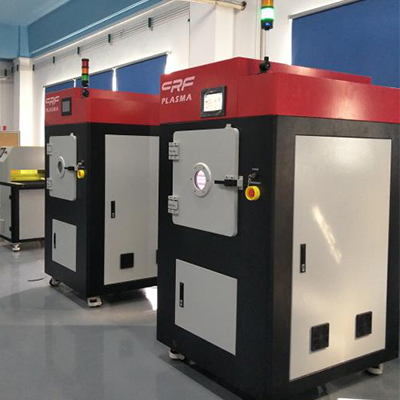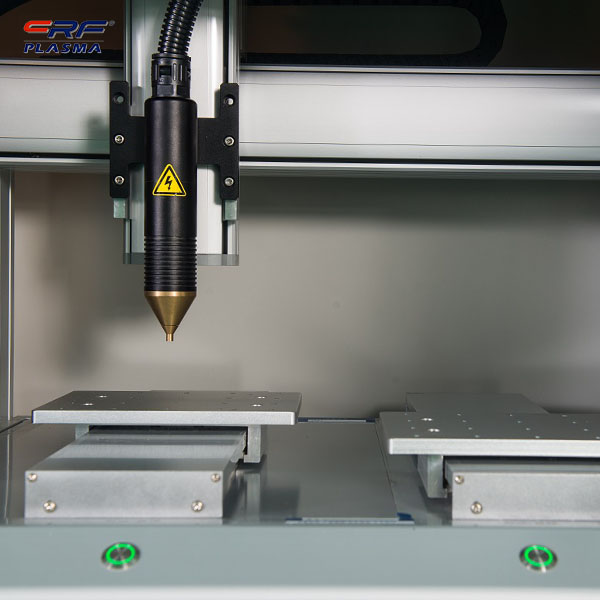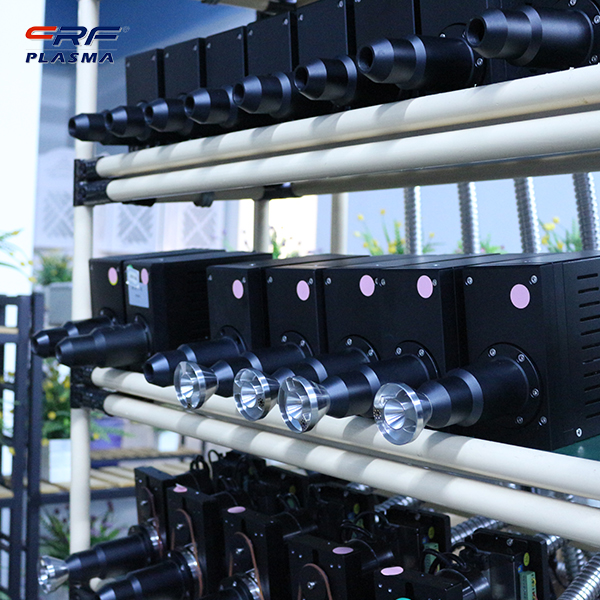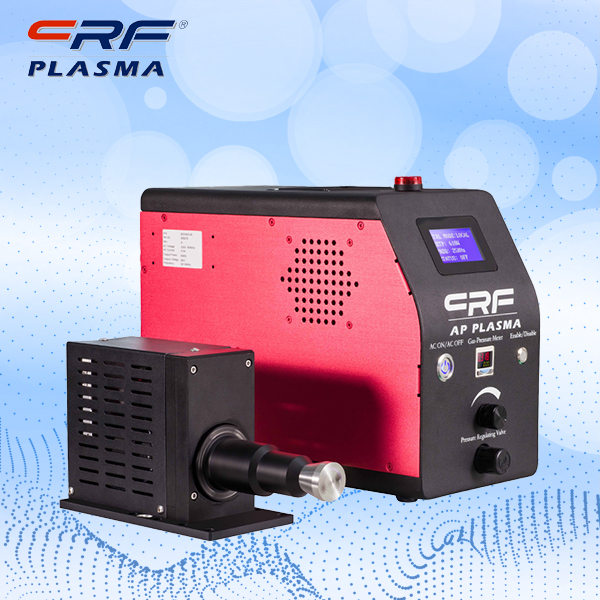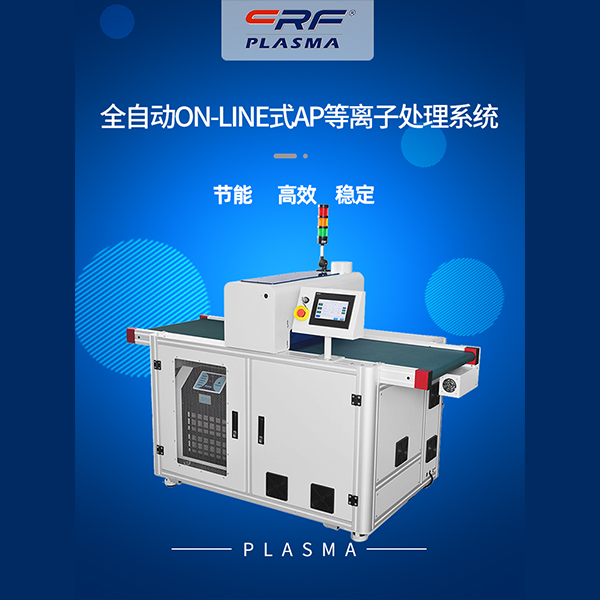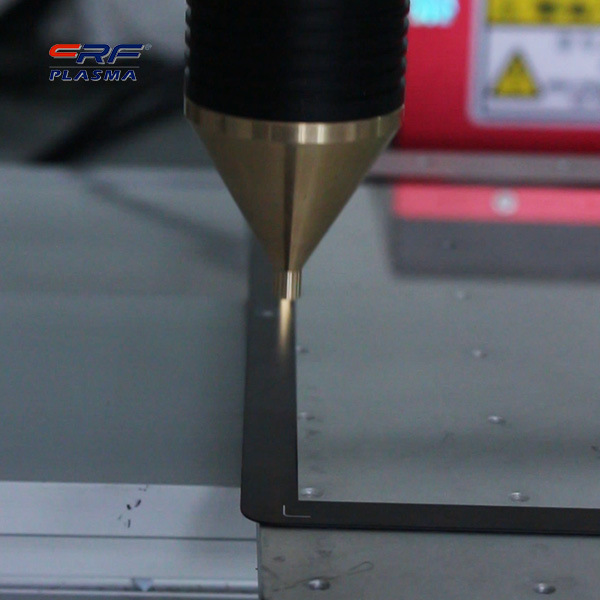
Welcome to Shenzhen Sing Fung Intelligent Manufacturing Co., Ltd.
E-mail:shaobo@sfi-crf.com
Pure ethane can undergo dehydrogenation reaction under the action of plasma plasma at low temperature and atmospheric pressure
- Categories:Industry News
- Author:Plasma cleaning machine-CRF plasma plasma equipment-plasma surface treatment machine manufacturer-chengfeng intelligent manufacturing
- Origin:
- Time of issue:2022-01-20
- Views:
(Summary description)Pure ethane can undergo dehydrogenation reaction under the action of plasma plasma at low temperature and atmospheric pressure: Under atmospheric pressure pulsed corona plasma conditions, the conversion rate of C2H6 and the yield of C2H2 increased with the increase of energy density, the yield of C2H4 increased slightly, but the yield of CH4 did not change much with the increase of plasma energy density. When the plasma energy density was 860 kJ/mol, the conversion of C2H6 was 23.2%, and the sum of the yields of C2H4 and C2H2 was 11.6%. It is generally believed that in a flow plasma reactor, when the flow rate of the reactant gas is constant, the high-energy electron density and its average energy in the system are mainly determined by the plasma energy density. The plasma power increases, the high-energy electron density and its average energy in the system increase, the elastic and inelastic collision probability between high-energy electrons and C2H6 molecules and the transmitted energy increase, and the CH bond and CC bond of C2H6 are more likely to break, and their breakage increases. The concentration of the free radicals formed also increases, and the probability of the free radicals to form products by recombination also increases. Therefore, the conversion rate of C2H6 and the yield of C2H2 tend to increase with the increase of plasma power. The insignificant upward trend of C2H4 yield and CH4 yield with the increase of plasma injection power may be related to the fact that C2H4 and CH4 are the primary reaction products of the reaction, and C2H2 is more stable. Chemical bond Dissociation energy/(kJ/mol) Dissociation energy/(eV/mol) CH3—CH3 367.8 3.8 C2H5—H 409.6 4.2 CH2=CH2 681.3 7.1 C2H3—H 434.7 4.5 CH≡CH 964.9 10.0 C2H—H 501.7 5.2 The main gas phase products of the conversion reaction of pure C2H6 under plasma conditions are: C2H4, C2H2, H2 and CH4, and the solid product is carbon deposition. In order to explore the possible mechanism of the conversion of pure ethane under the action of plasma, the conversion of pure ethylene was investigated under the same plasma conditions. The main products of the reaction were: C2H2, CH4 and a small amount of carbon deposits. According to the above experimental facts, combined with the mechanism of methane conversion reaction and plasma characteristics under the action of plasma, it is speculated that the process of C2H6 conversion reaction under plasma conditions is as follows. (1) The plasma field produces high-energy electrons. The free electrons are accelerated under the action of the electric field E to generate high-energy electrons e*: e + E → e* (3-26) (2) Initiates a free radical reaction. High-energy electrons collide elastically and inelastically with ethane molecules. Depending on the energy of the high (3-26) energy electrons, the collision leads to an increase in the kinetic energy or internal energy of the ethane molecule, which breaks the C-H and C-O bonds of ethane to generate various free radicals: C2H6 + e* → C2H5 + H + e (3-27) C2H6 + e* → 2CH3 + e (3-28) According to the chemical bond dissociation energy data in Table 3-1, the reaction formula (3-28) (C-C bond breaking) is more than the reaction Equation (3-27) (C-H bond cleavage) is easier to carry out. (3) Chain transfer reaction: H + C2H6 → C2H5 + H2 (3-29) CH3 + C2H6 → C2H5 + CH4 (3-30) CH3 + e* → CH2 + H (3-31) CH2 + e* → CH + H (3-32) CH + e* → C + H (3-33) (4) Chain termination reaction: CH3 + H → CH4 (3-34) CH2 + CH2 → C2H4 (3-35) CH3 + CH → C2H4 (3-36) CH + CH → C2H2 (3-37) Under the low temperature and normal pressure, pure ethane can undergo dehydrogenation reaction under the action of plasma to generate acetylene, ethylene, a small amount of methane and carbon deposits, but there are problems such as low conversion rate and the formation of carbon deposits on the reactor wall. According to the ethane dehydrogenation reaction mechanism under chemical catalytic conditions, for the ethane dehydrogenation reaction under plasma conditions, the CH bond of ethane is preferentially broken to form C2H5 radicals, and the C2H5 radicals are further dehydrogenated to ethylene. Key pathways for hydrogen reactions in practical applications. Therefore, the effect of the added gas and plasma on the ethane dehydrogenation reaction is particularly important.
Pure ethane can undergo dehydrogenation reaction under the action of plasma plasma at low temperature and atmospheric pressure
(Summary description)Pure ethane can undergo dehydrogenation reaction under the action of plasma plasma at low temperature and atmospheric pressure:
Under atmospheric pressure pulsed corona plasma conditions, the conversion rate of C2H6 and the yield of C2H2 increased with the increase of energy density, the yield of C2H4 increased slightly, but the yield of CH4 did not change much with the increase of plasma energy density. When the plasma energy density was 860 kJ/mol, the conversion of C2H6 was 23.2%, and the sum of the yields of C2H4 and C2H2 was 11.6%. It is generally believed that in a flow plasma reactor, when the flow rate of the reactant gas is constant, the high-energy electron density and its average energy in the system are mainly determined by the plasma energy density. The plasma power increases, the high-energy electron density and its average energy in the system increase, the elastic and inelastic collision probability between high-energy electrons and C2H6 molecules and the transmitted energy increase, and the CH bond and CC bond of C2H6 are more likely to break, and their breakage increases. The concentration of the free radicals formed also increases, and the probability of the free radicals to form products by recombination also increases. Therefore, the conversion rate of C2H6 and the yield of C2H2 tend to increase with the increase of plasma power. The insignificant upward trend of C2H4 yield and CH4 yield with the increase of plasma injection power may be related to the fact that C2H4 and CH4 are the primary reaction products of the reaction, and C2H2 is more stable.
Chemical bond Dissociation energy/(kJ/mol) Dissociation energy/(eV/mol)
CH3—CH3 367.8 3.8
C2H5—H 409.6 4.2
CH2=CH2 681.3 7.1
C2H3—H 434.7 4.5
CH≡CH 964.9 10.0
C2H—H 501.7 5.2
The main gas phase products of the conversion reaction of pure C2H6 under plasma conditions are: C2H4, C2H2, H2 and CH4, and the solid product is carbon deposition. In order to explore the possible mechanism of the conversion of pure ethane under the action of plasma, the conversion of pure ethylene was investigated under the same plasma conditions. The main products of the reaction were: C2H2, CH4 and a small amount of carbon deposits. According to the above experimental facts, combined with the mechanism of methane conversion reaction and plasma characteristics under the action of plasma, it is speculated that the process of C2H6 conversion reaction under plasma conditions is as follows.
(1) The plasma field produces high-energy electrons. The free electrons are accelerated under the action of the electric field E to generate high-energy electrons e*:
e + E → e* (3-26)
(2) Initiates a free radical reaction. High-energy electrons collide elastically and inelastically with ethane molecules. Depending on the energy of the high (3-26) energy electrons, the collision leads to an increase in the kinetic energy or internal energy of the ethane molecule, which breaks the C-H and C-O bonds of ethane to generate various free radicals:
C2H6 + e* → C2H5 + H + e (3-27)
C2H6 + e* → 2CH3 + e (3-28)
According to the chemical bond dissociation energy data in Table 3-1, the reaction formula (3-28) (C-C bond breaking) is more than the reaction
Equation (3-27) (C-H bond cleavage) is easier to carry out.
(3) Chain transfer reaction:
H + C2H6 → C2H5 + H2 (3-29)
CH3 + C2H6 → C2H5 + CH4 (3-30)
CH3 + e* → CH2 + H (3-31)
CH2 + e* → CH + H (3-32)
CH + e* → C + H (3-33)
(4) Chain termination reaction:
CH3 + H → CH4 (3-34)
CH2 + CH2 → C2H4 (3-35)
CH3 + CH → C2H4 (3-36)
CH + CH → C2H2 (3-37)
Under the low temperature and normal pressure, pure ethane can undergo dehydrogenation reaction under the action of plasma to generate acetylene, ethylene, a small amount of methane and carbon deposits, but there are problems such as low conversion rate and the formation of carbon deposits on the reactor wall. According to the ethane dehydrogenation reaction mechanism under chemical catalytic conditions, for the ethane dehydrogenation reaction under plasma conditions, the CH bond of ethane is preferentially broken to form C2H5 radicals, and the C2H5 radicals are further dehydrogenated to ethylene. Key pathways for hydrogen reactions in practical applications. Therefore, the effect of the added gas and plasma on the ethane dehydrogenation reaction is particularly important.
- Categories:Industry News
- Author:Plasma cleaning machine-CRF plasma plasma equipment-plasma surface treatment machine manufacturer-chengfeng intelligent manufacturing
- Origin:
- Time of issue:2022-01-20 21:35
- Views:
Pure ethane can undergo dehydrogenation reaction under the action of plasma plasma at low temperature and atmospheric pressure:
Under atmospheric pressure pulsed corona plasma conditions, the conversion rate of C2H6 and the yield of C2H2 increased with the increase of energy density, the yield of C2H4 increased slightly, but the yield of CH4 did not change much with the increase of plasma energy density. When the plasma energy density was 860 kJ/mol, the conversion of C2H6 was 23.2%, and the sum of the yields of C2H4 and C2H2 was 11.6%. It is generally believed that in a flow plasma reactor, when the flow rate of the reactant gas is constant, the high-energy electron density and its average energy in the system are mainly determined by the plasma energy density. The plasma power increases, the high-energy electron density and its average energy in the system increase, the elastic and inelastic collision probability between high-energy electrons and C2H6 molecules and the transmitted energy increase, and the CH bond and CC bond of C2H6 are more likely to break, and their breakage increases. The concentration of the free radicals formed also increases, and the probability of the free radicals to form products by recombination also increases. Therefore, the conversion rate of C2H6 and the yield of C2H2 tend to increase with the increase of plasma power. The insignificant upward trend of C2H4 yield and CH4 yield with the increase of plasma injection power may be related to the fact that C2H4 and CH4 are the primary reaction products of the reaction, and C2H2 is more stable.
Chemical bond Dissociation energy/(kJ/mol) Dissociation energy/(eV/mol)
CH3—CH3 367.8 3.8
C2H5—H 409.6 4.2
CH2=CH2 681.3 7.1
C2H3—H 434.7 4.5
CH≡CH 964.9 10.0
C2H—H 501.7 5.2
 The main gas phase products of the conversion reaction of pure C2H6 under plasma conditions are: C2H4, C2H2, H2 and CH4, and the solid product is carbon deposition. In order to explore the possible mechanism of the conversion of pure ethane under the action of plasma, the conversion of pure ethylene was investigated under the same plasma conditions. The main products of the reaction were: C2H2, CH4 and a small amount of carbon deposits. According to the above experimental facts, combined with the mechanism of methane conversion reaction and plasma characteristics under the action of plasma, it is speculated that the process of C2H6 conversion reaction under plasma conditions is as follows.
The main gas phase products of the conversion reaction of pure C2H6 under plasma conditions are: C2H4, C2H2, H2 and CH4, and the solid product is carbon deposition. In order to explore the possible mechanism of the conversion of pure ethane under the action of plasma, the conversion of pure ethylene was investigated under the same plasma conditions. The main products of the reaction were: C2H2, CH4 and a small amount of carbon deposits. According to the above experimental facts, combined with the mechanism of methane conversion reaction and plasma characteristics under the action of plasma, it is speculated that the process of C2H6 conversion reaction under plasma conditions is as follows.
(1) The plasma field produces high-energy electrons. The free electrons are accelerated under the action of the electric field E to generate high-energy electrons e*:
e + E → e* (3-26)
(2) Initiates a free radical reaction. High-energy electrons collide elastically and inelastically with ethane molecules. Depending on the energy of the high (3-26) energy electrons, the collision leads to an increase in the kinetic energy or internal energy of the ethane molecule, which breaks the C-H and C-O bonds of ethane to generate various free radicals:
C2H6 + e* → C2H5 + H + e (3-27)
C2H6 + e* → 2CH3 + e (3-28)
According to the chemical bond dissociation energy data in Table 3-1, the reaction formula (3-28) (C-C bond breaking) is more than the reaction
Equation (3-27) (C-H bond cleavage) is easier to carry out.
(3) Chain transfer reaction:
H + C2H6 → C2H5 + H2 (3-29)
CH3 + C2H6 → C2H5 + CH4 (3-30)
CH3 + e* → CH2 + H (3-31)
CH2 + e* → CH + H (3-32)
CH + e* → C + H (3-33)
(4) Chain termination reaction:
CH3 + H → CH4 (3-34)
CH2 + CH2 → C2H4 (3-35)
CH3 + CH → C2H4 (3-36)
CH + CH → C2H2 (3-37)
Under the low temperature and normal pressure, pure ethane can undergo dehydrogenation reaction under the action of plasma to generate acetylene, ethylene, a small amount of methane and carbon deposits, but there are problems such as low conversion rate and the formation of carbon deposits on the reactor wall. According to the ethane dehydrogenation reaction mechanism under chemical catalytic conditions, for the ethane dehydrogenation reaction under plasma conditions, the CH bond of ethane is preferentially broken to form C2H5 radicals, and the C2H5 radicals are further dehydrogenated to ethylene. Key pathways for hydrogen reactions in practical applications. Therefore, the effect of the added gas and plasma on the ethane dehydrogenation reaction is particularly important.
Scan the QR code to read on your phone

TEL:0755-3367 3020 / 0755-3367 3019

E-mail:sales-sfi@sfi-crf.com

ADD:Mabao Industrial Zone, Huangpu, Baoan District, Shenzhen




